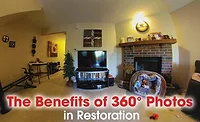Restorer's Perspective: The Importance of IAQ
The Importance of IAQ in Remediation
The images of the aftermath from a disaster are often what capture our attention, but as the clean-up and restoration begins, a critical part of the process is what you can’t see.
While many contractors and businesses go into the air duct cleaning industry as an affordable option for increasing revenue, the restoration industry has a unique position because of how important it is for providing a thorough cleaning.
While air ducts naturally accumulate particles and pollutants, those levels reach new heights after fire, smoke, or water-related damage. While routine cleaning is encouraged, air duct cleaning is a necessity following any disaster or damage in a home or business. Since air ducts are hidden, the damage and effect can be easy for consumers, and even contractors, to overlook.
Failing to properly clean the air ducts after a disaster can have many implications for the property owner including impacting the indoor air quality and causing further harm to the heating and cooling system. Any remnants left in the air ducts could be transferred throughout the HVAC system and reenter the indoor environment. According to the National Air Duct Cleaning Association (NACDA), pollutants in the home can be pulled into the HVAC system and recirculated up to seven times a day, on average. Since 1990, the U.S. Environmental Protection Agency (EPA) has consistently ranked indoor air pollution as one of the top five environmental risks to public health.
In situations with water damage, there is also the risk for mold to develop and grow if not properly addressed. The U.S. Centers for Disease Control and Prevention, the Institute of Medicine of the U.S. National Academy of Sciences, the World Health Organization, and Health Canada all agree living or working in a building with mold damage increases the risk of respiratory disease.
There are many portable systems available that make it easier to transport, can be operated by one person and are compact enough to navigate through smaller spaces such as attics and crawl spaces.
When purchasing equipment, it’s important to find a company that provides adequate training and support to ensure contractors understand the correct and most effective way to use the equipment perform air duct cleaning. Inadequate training can result in releasing the contaminants back into the air inside the home.
For homeowners, the services are covered by insurance so they won’t feel the extra cost and they’ll rest easier knowing their indoor air quality isn’t affected by the residuals. They will also have greater confidence in the future performance of their HVAC equipment. By not providing a proper cleaning, the homeowner could face potential issues with the performance of their HVAC system and cause an increase in energy bills.
Offering air duct cleaning can give contractors a competitive advantage. Indoor air quality is increasingly becoming a concern for homeowners and facility managers, whether or not there has been a disaster on the property.
We all strive for customer satisfaction. With the growing importance of indoor air quality, be sure to include air duct cleaning in your restoration services.
Looking for a reprint of this article?
From high-res PDFs to custom plaques, order your copy today!






